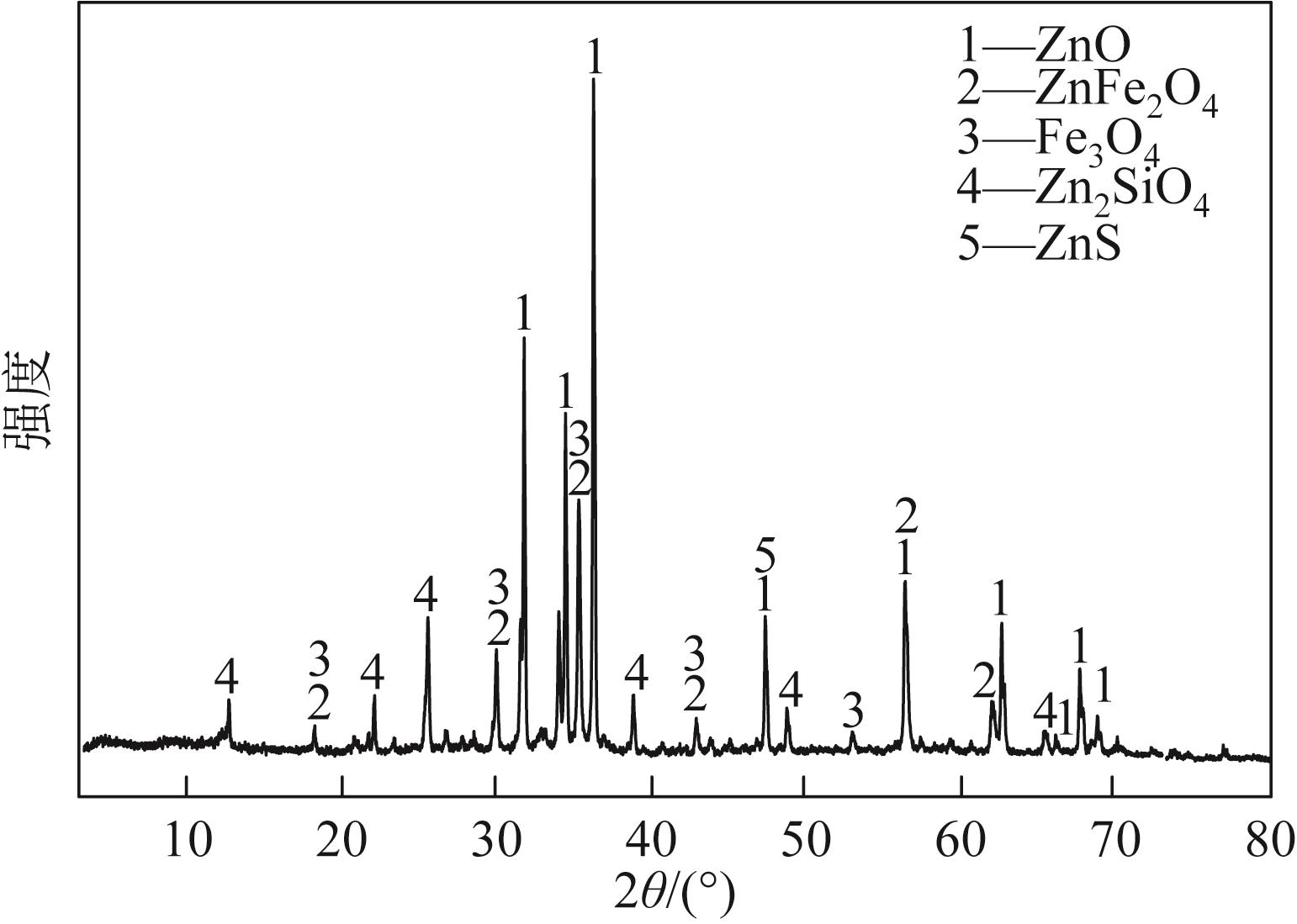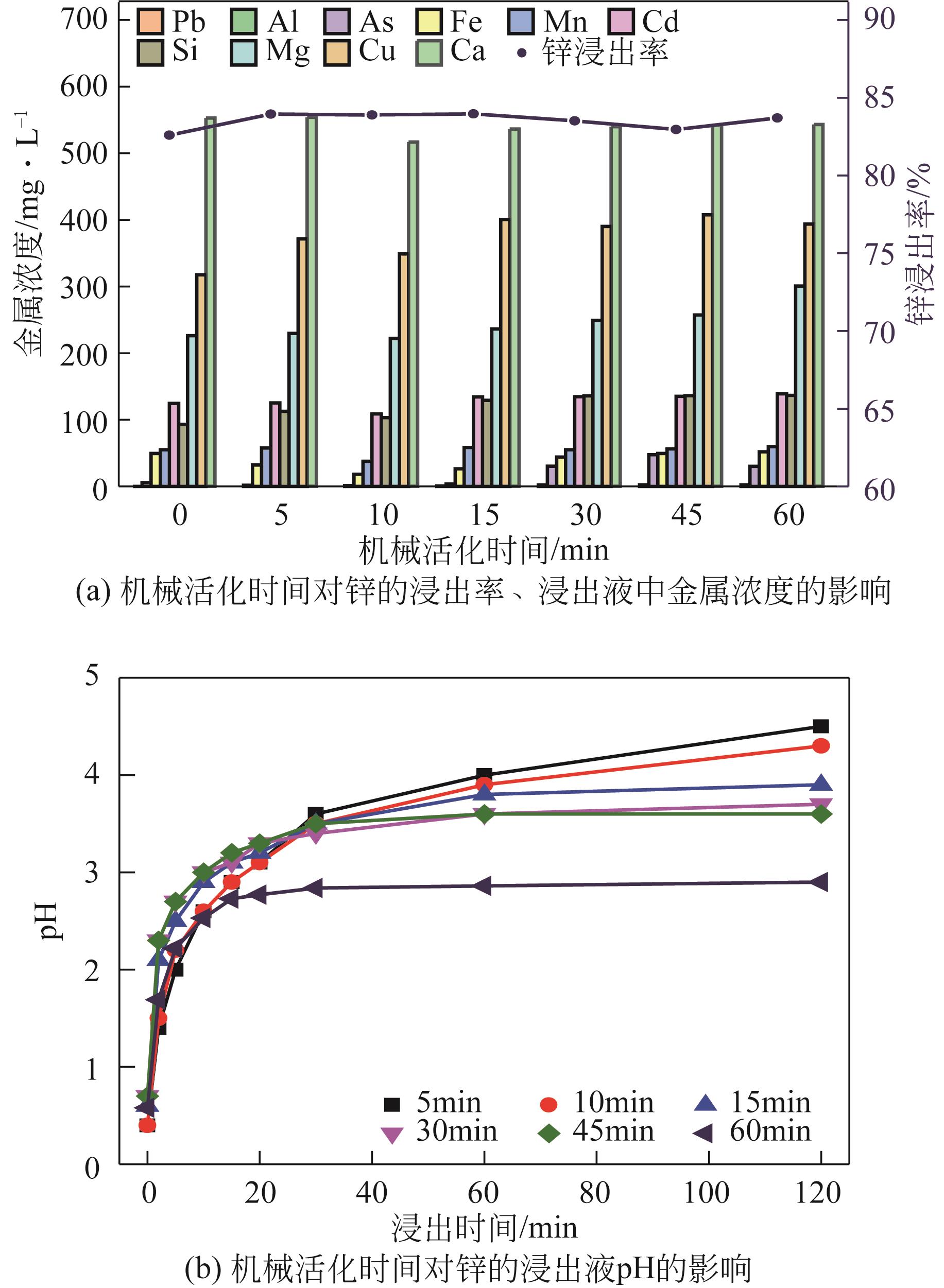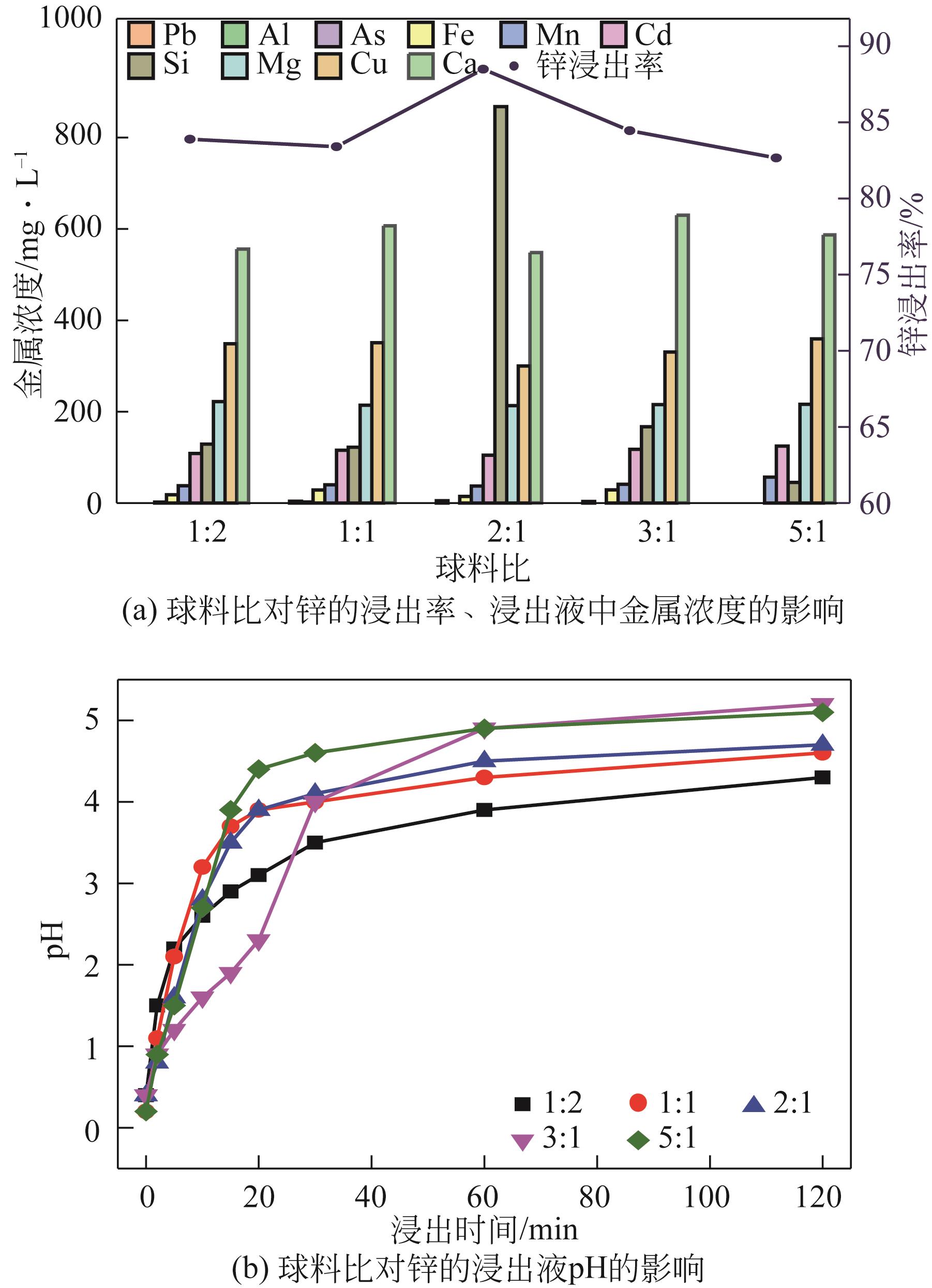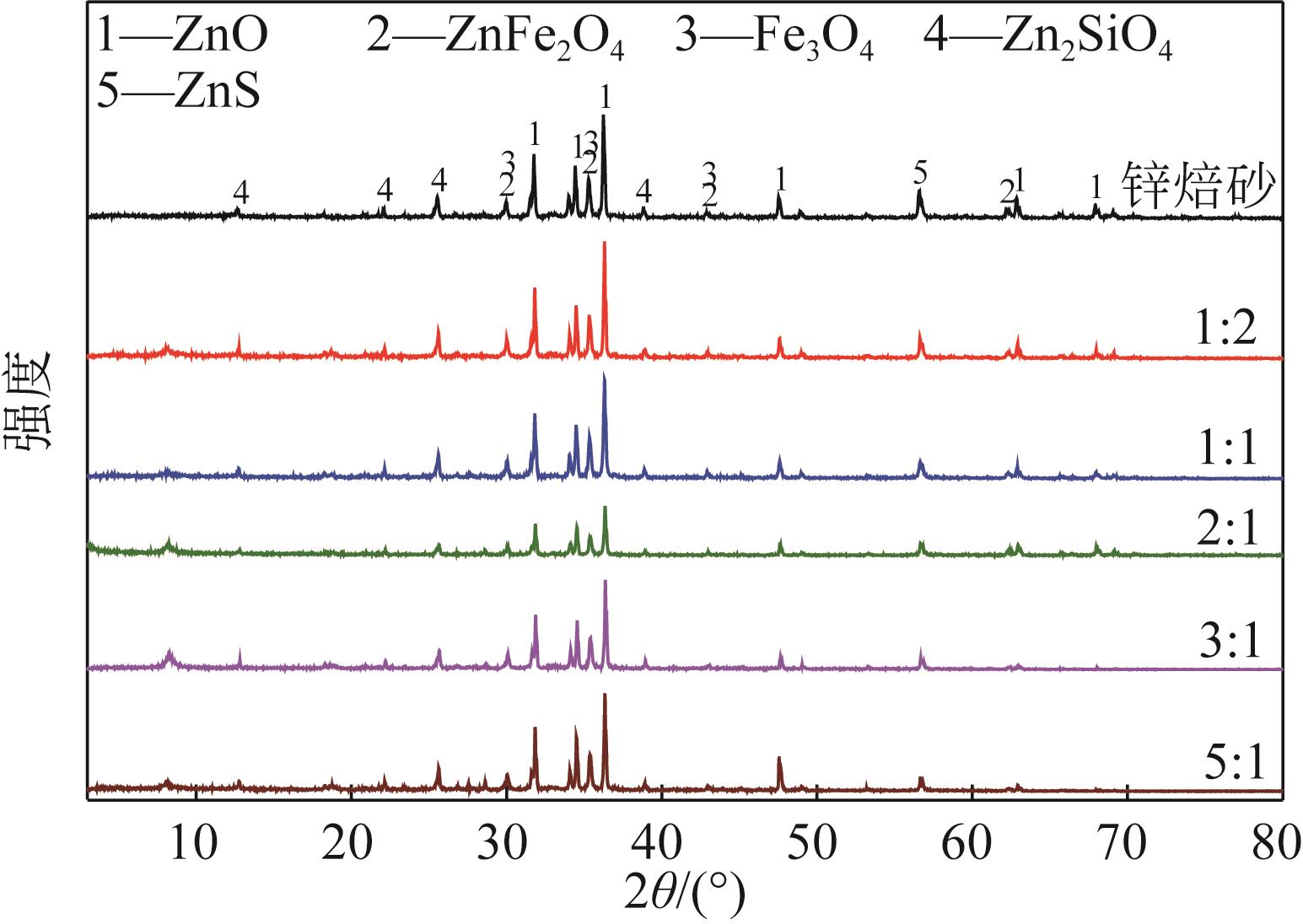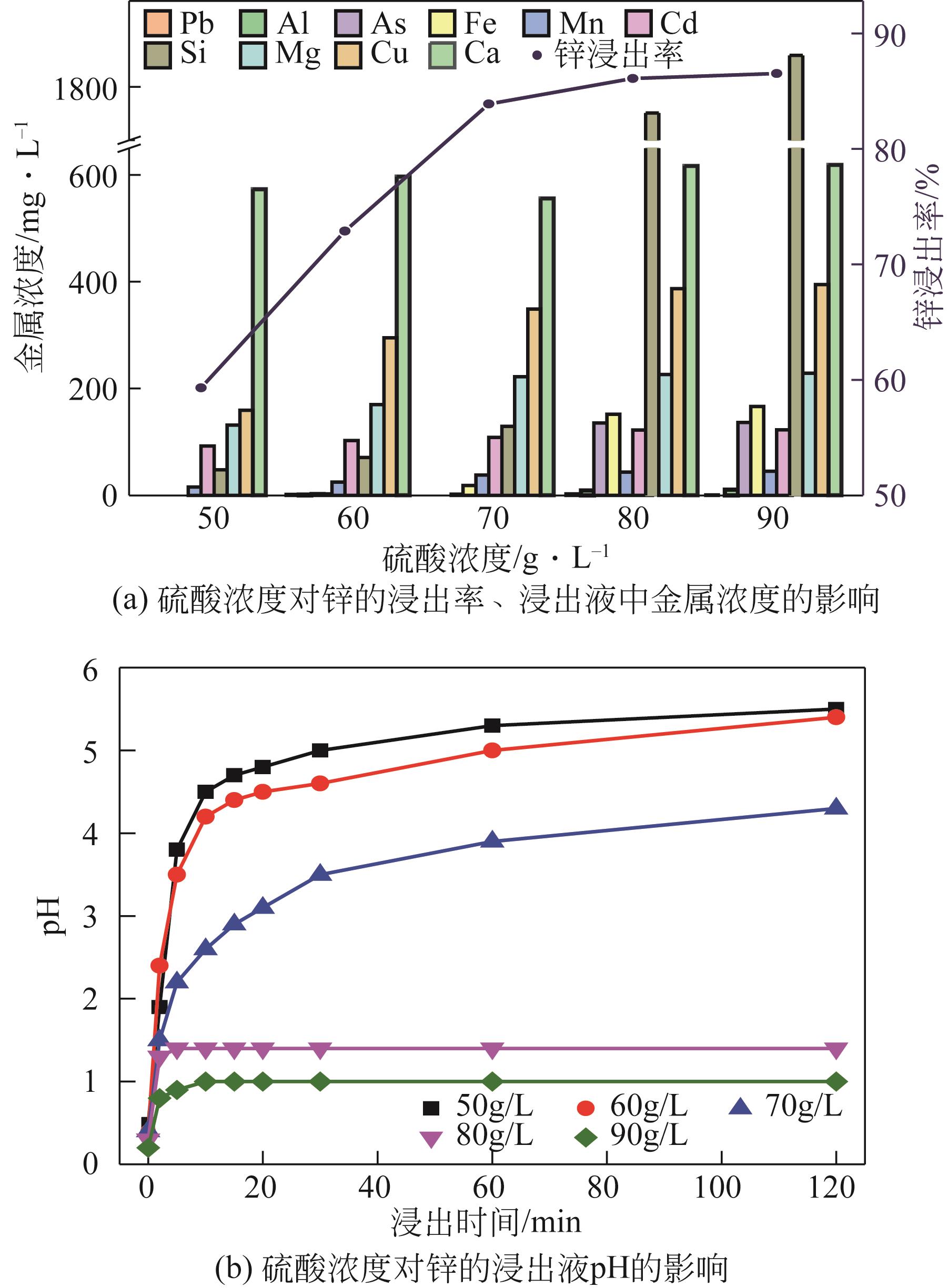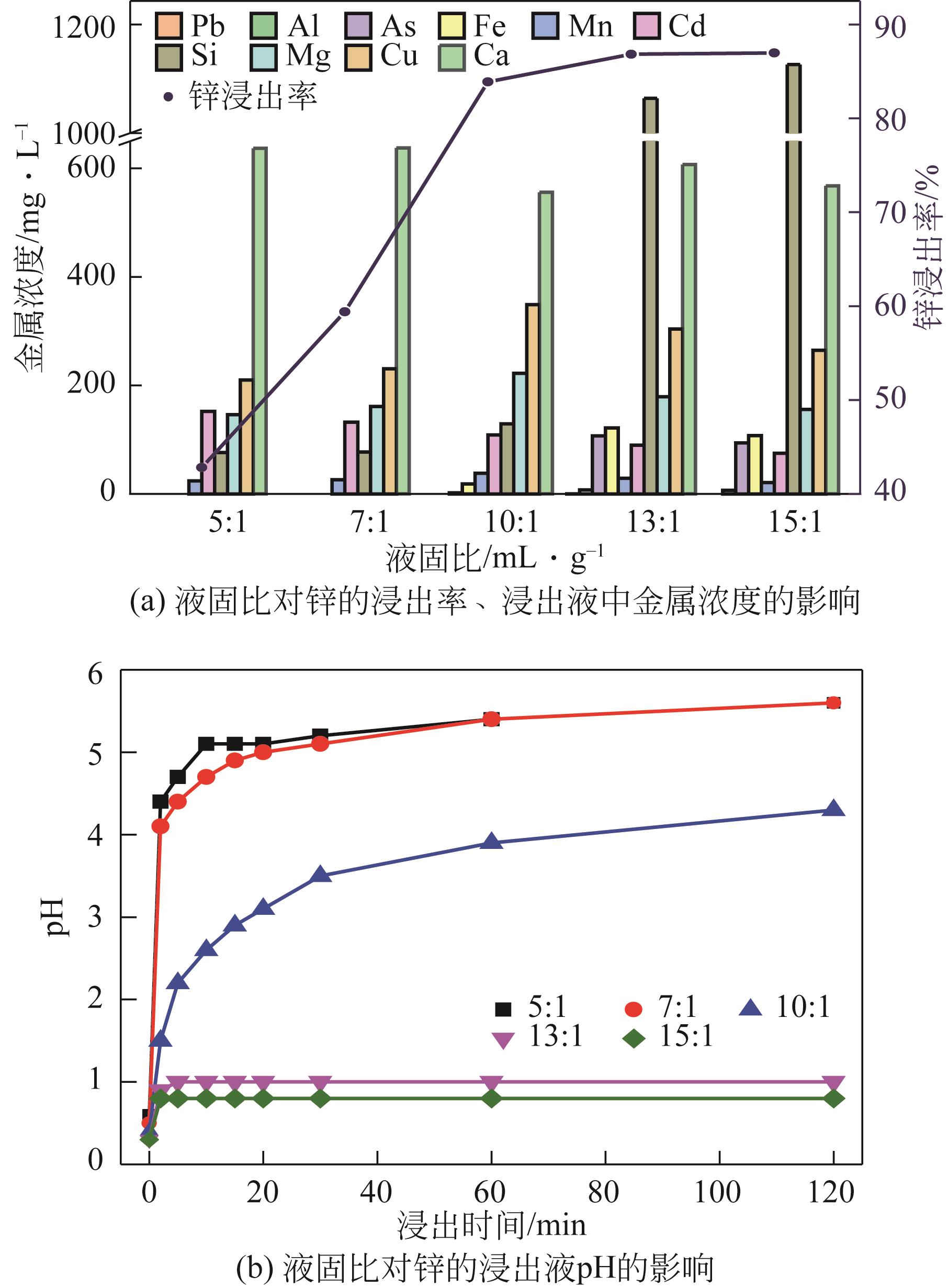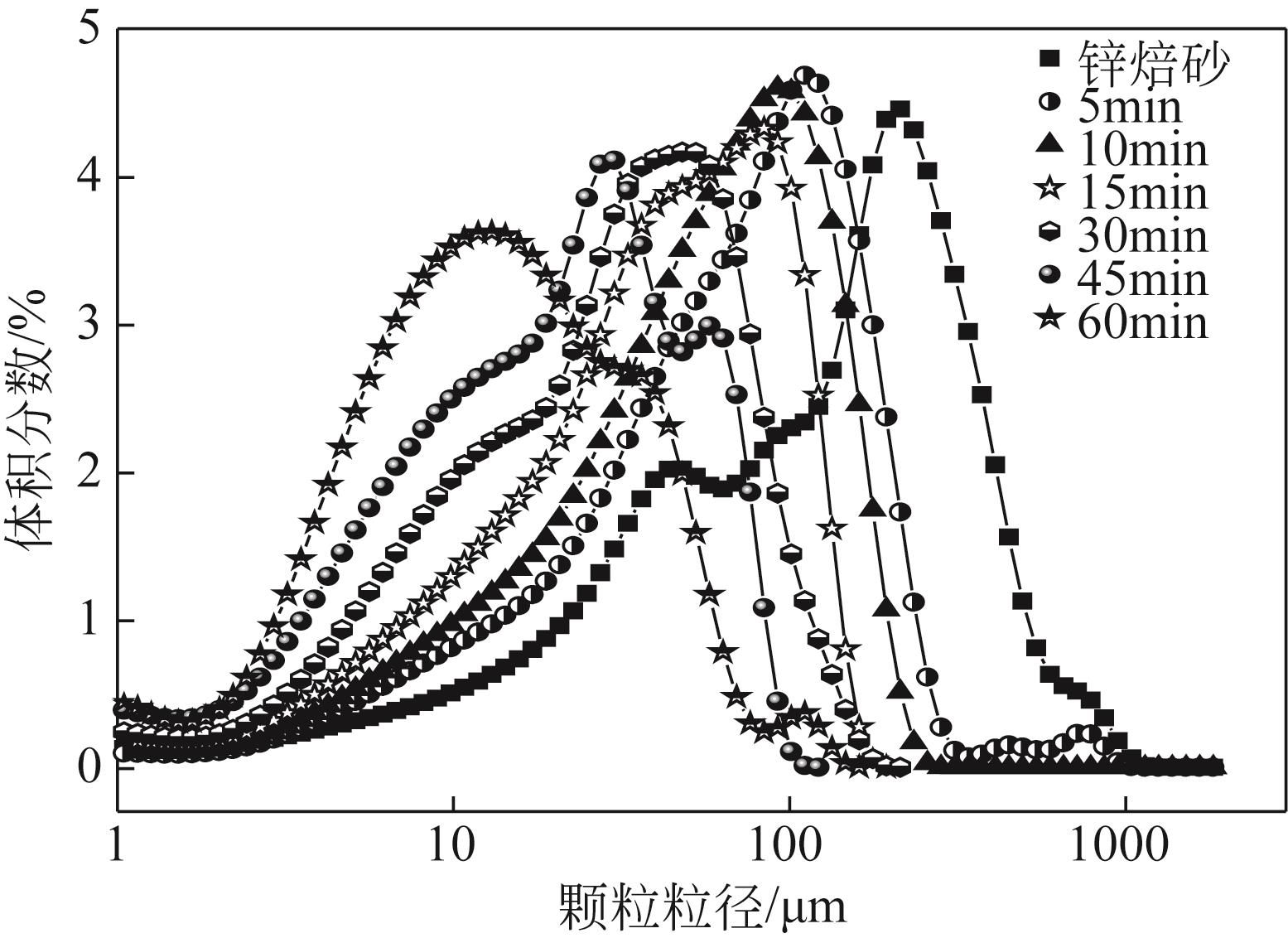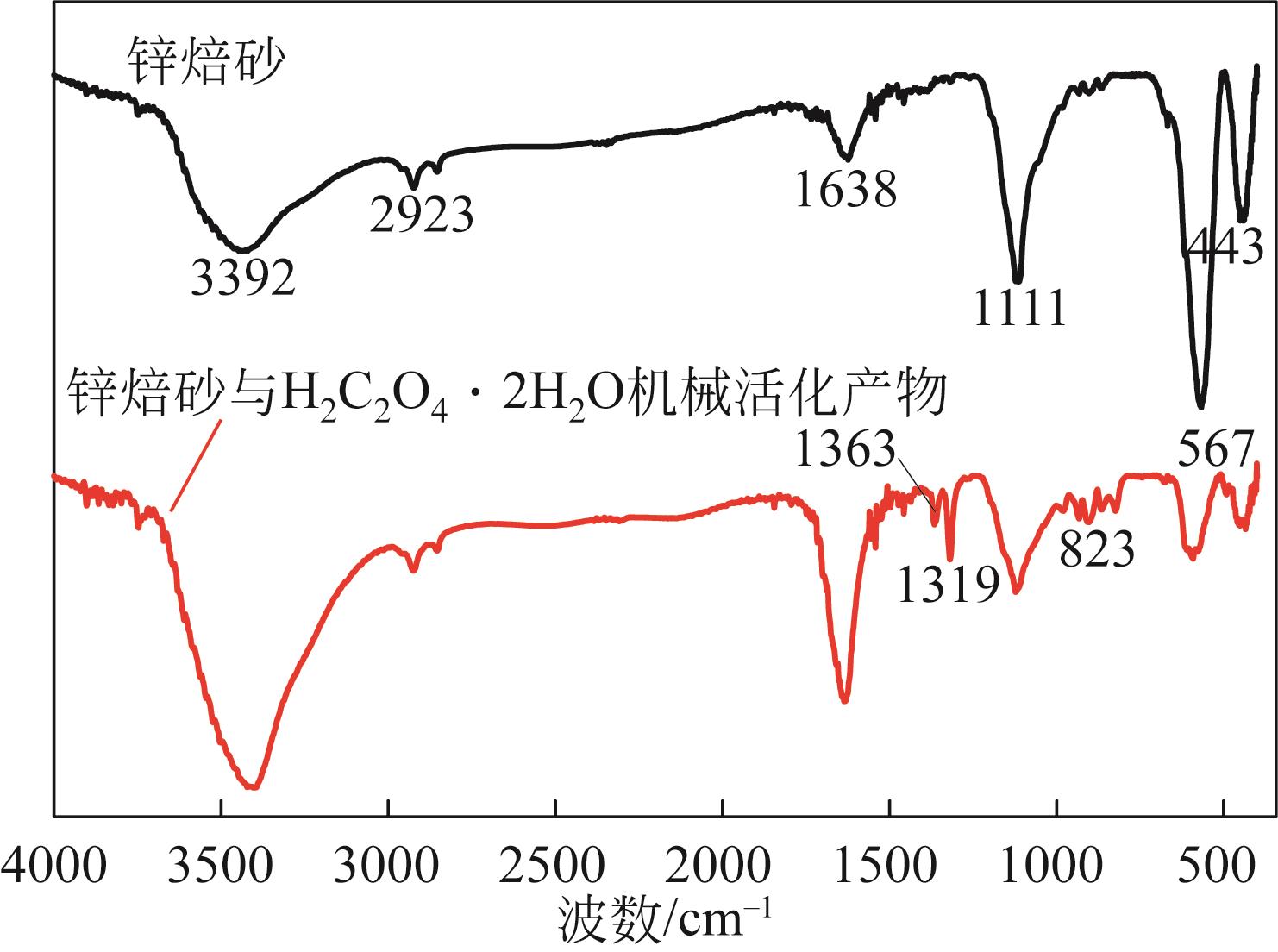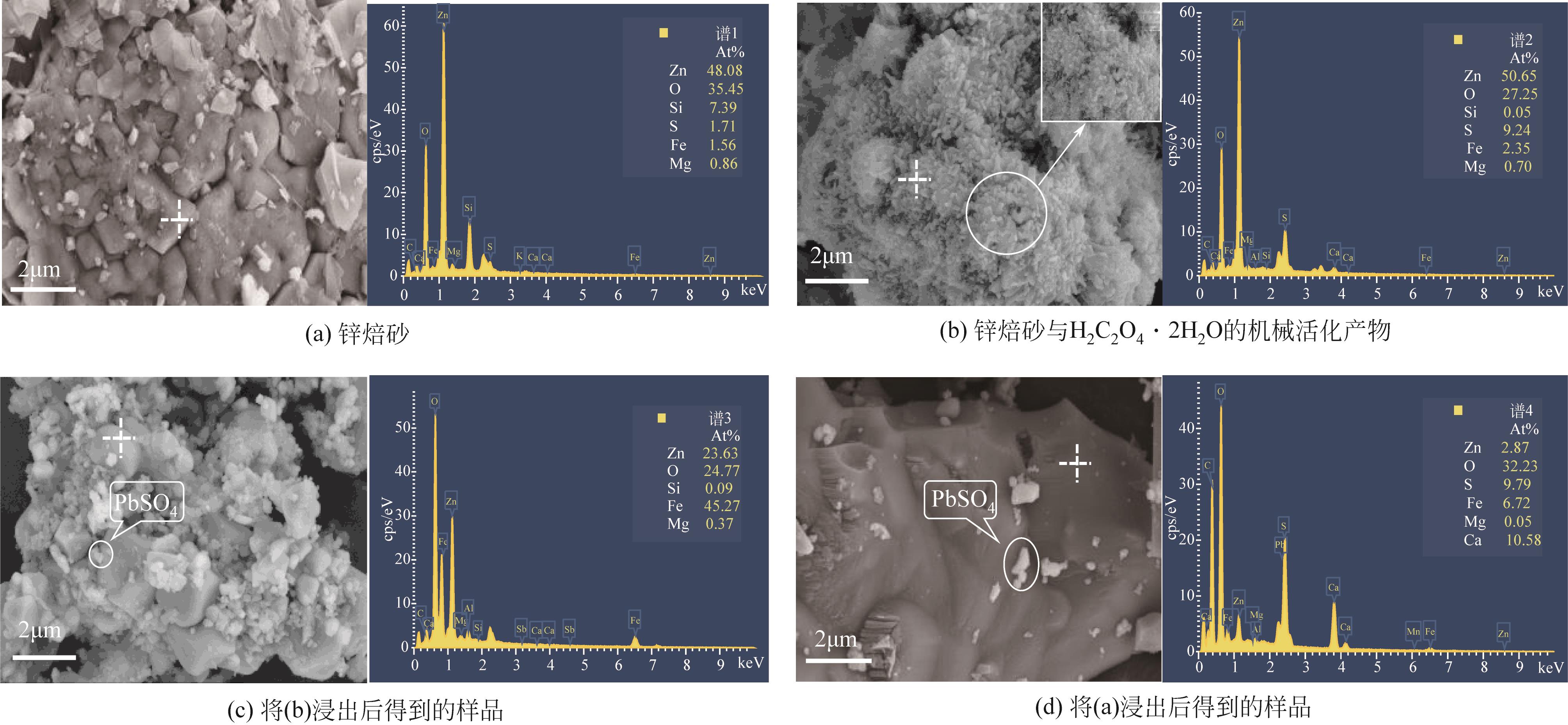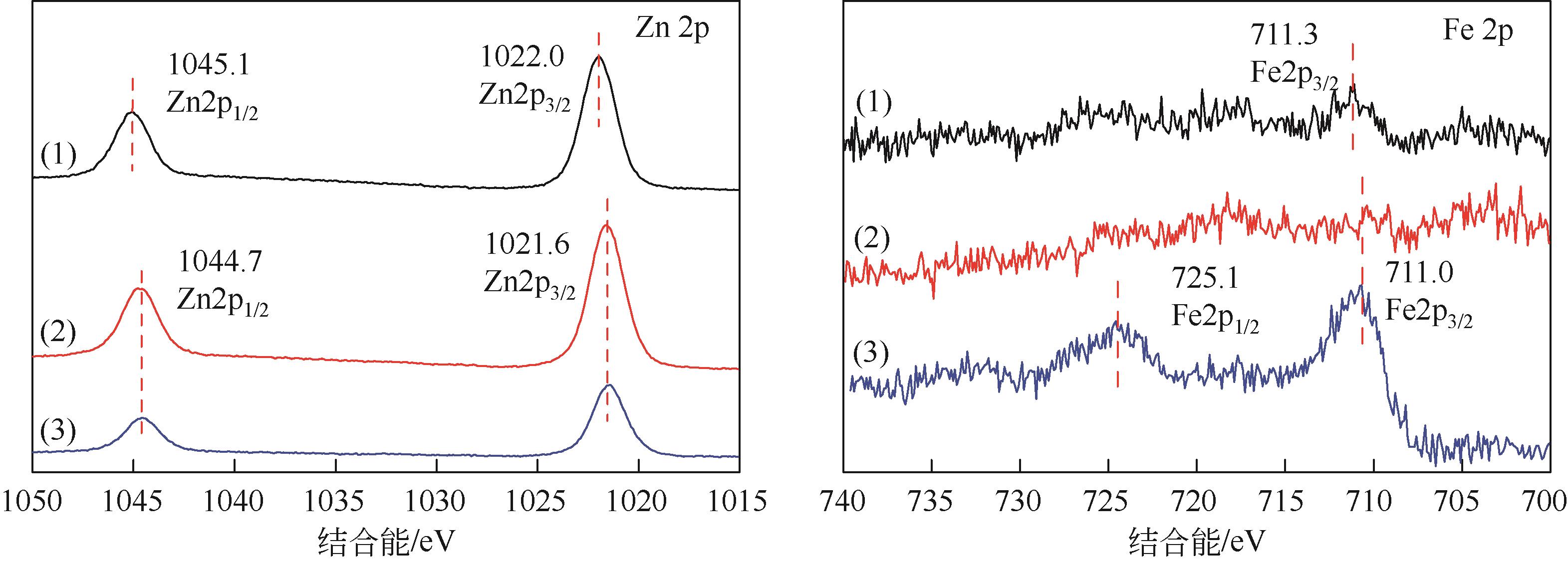化工进展 ›› 2023, Vol. 42 ›› Issue (3): 1649-1658.DOI: 10.16085/j.issn.1000-6613.2022-0991
机械活化强化锌焙砂中锌的浸出
陈绍勤1( ), 胡玲1, 雷天涯1, 王蓉2, 舒建成1, 陈梦君1(
), 胡玲1, 雷天涯1, 王蓉2, 舒建成1, 陈梦君1( )
)
- 1.西南科技大学固体废物处理与资源化教育部重点实验室,四川 绵阳 621000
2.西南科技大学国防科技学院,四川 绵阳 621000
-
收稿日期:2022-05-27修回日期:2022-06-17出版日期:2023-03-15发布日期:2023-04-10 -
通讯作者:陈梦君 -
作者简介:陈绍勤(1997—),女,硕士研究生,研究方向为固体废物(电子垃圾/危险废物)循环利用与污染控制。E-mail:1157332105@qq.com。 -
基金资助:四川省科技支撑项目(2022NSFSC1026)
Mechanical activation for zinc enhanced leaching from zinc calcine
CHEN Shaoqin1( ), HU Ling1, LEI Tianya1, WANG Rong2, SHU Jiancheng1, CHEN Mengjun1(
), HU Ling1, LEI Tianya1, WANG Rong2, SHU Jiancheng1, CHEN Mengjun1( )
)
- 1.Key Laboratory of Solid Waste Treatment and Resource Recycle, Ministry of Education, Southwest University of Science and Technology, Mianyang 621000, Sichuan, China
2.National Institute of Defense Technology, Southwest University of Science and Technology, Mianyang 621000, Sichuan, China
-
Received:2022-05-27Revised:2022-06-17Online:2023-03-15Published:2023-04-10 -
Contact:CHEN Mengjun
摘要:
锌精矿焙烧阶段产生的铁酸锌(ZnFe2O4)是一类具有尖晶石结构的复合氧化物,性质稳定,不溶于稀酸和碱,在常规浸出条件下,仍有20%的锌以铁酸锌的形式存在于锌浸渣中,导致锌精矿焙烧产物的锌浸出率不高,一般为80%左右。机械活化具有使矿物晶格产生缺陷,降低反应对温度、酸浓度等条件依赖程度的优点。因此,本文采用机械活化对锌焙砂进行预处理,以硫酸为浸出剂,研究了机械活化时间、球料比、硫酸浓度、液固比、温度对锌的浸出率及其他杂质离子的影响规律。结果表明:锌的浸出率随机械活化时间的延长呈现出先增大后降低的趋势。机械活化(H2C2O4·2H2O与锌焙砂的质量比为3.60%,球料比为2∶1,球磨时间10min)-酸浸(70g/L H2SO4,液固比为10∶1,温度为35℃)工艺结果表明,锌的浸出率为87.61%,与未机械活化时相比(82.59%),锌的浸出率提高5个百分点。机理分析表明,机械活化使锌焙砂颗粒粒径变小,产生晶格畸变和局部破坏,锌焙砂中铁酸锌的结晶度从47.90%降至34.50%,使得浸出剂更易渗透到锌焙砂颗粒内部从而促进锌的浸出。
中图分类号:
引用本文
陈绍勤, 胡玲, 雷天涯, 王蓉, 舒建成, 陈梦君. 机械活化强化锌焙砂中锌的浸出[J]. 化工进展, 2023, 42(3): 1649-1658.
CHEN Shaoqin, HU Ling, LEI Tianya, WANG Rong, SHU Jiancheng, CHEN Mengjun. Mechanical activation for zinc enhanced leaching from zinc calcine[J]. Chemical Industry and Engineering Progress, 2023, 42(3): 1649-1658.
| 成分 | 质量分数/% |
|---|---|
| ZnO | 64.23 |
| Fe2O3 | 13.62 |
| SO3 | 9.55 |
| SiO2 | 5.00 |
| PbO | 2.08 |
| CaO | 1.56 |
| CuO | 1.09 |
| Al2O3 | 0.68 |
| MgO | 0.61 |
| MnO | 0.45 |
| CdO | 0.27 |
| As2O3 | 0.24 |
表1 锌焙砂的XRF化学组成
| 成分 | 质量分数/% |
|---|---|
| ZnO | 64.23 |
| Fe2O3 | 13.62 |
| SO3 | 9.55 |
| SiO2 | 5.00 |
| PbO | 2.08 |
| CaO | 1.56 |
| CuO | 1.09 |
| Al2O3 | 0.68 |
| MgO | 0.61 |
| MnO | 0.45 |
| CdO | 0.27 |
| As2O3 | 0.24 |
| 物相 | 各物相占锌焙砂的 质量分数/% | 各物相中锌占总锌的 质量分数/% |
|---|---|---|
| ZnSO4 | 0.34 | 0.19 |
| ZnO | 49.42 | 53.22 |
| Zn2SiO4 | 21.86 | 17.18 |
| ZnFe2O4 | 24.40 | 8.83 |
| ZnS | 0.43 | 0.39 |
| 其他锌 | 3.54 | 20.19 |
表2 锌焙砂含锌物相分析
| 物相 | 各物相占锌焙砂的 质量分数/% | 各物相中锌占总锌的 质量分数/% |
|---|---|---|
| ZnSO4 | 0.34 | 0.19 |
| ZnO | 49.42 | 53.22 |
| Zn2SiO4 | 21.86 | 17.18 |
| ZnFe2O4 | 24.40 | 8.83 |
| ZnS | 0.43 | 0.39 |
| 其他锌 | 3.54 | 20.19 |
| 参数 | 值 |
|---|---|
| 机械活化时间/min | 5、10、15、20、30、60 |
| 球料比 | 1∶2、1∶1、2∶1、3∶1、5∶1 |
| 硫酸浓度/g·L-1 | 50、60、70、80、90 |
| 液固比/mL·g-1 | 5∶1、7∶1、10∶1、13∶1、15∶1 |
| 温度/℃ | 25、35、45、55、65 |
表3 参数设置
| 参数 | 值 |
|---|---|
| 机械活化时间/min | 5、10、15、20、30、60 |
| 球料比 | 1∶2、1∶1、2∶1、3∶1、5∶1 |
| 硫酸浓度/g·L-1 | 50、60、70、80、90 |
| 液固比/mL·g-1 | 5∶1、7∶1、10∶1、13∶1、15∶1 |
| 温度/℃ | 25、35、45、55、65 |
| 机械活化时间/min | d10/μm | d50/μm | d90/μm | 锌浸出率/% |
|---|---|---|---|---|
| 0 | 16.609 | 140.078 | 384.732 | 82.59 |
| 5 | 12.445 | 74.643 | 181.673 | 83.94 |
| 10 | 10.51 | 60.105 | 143.677 | 87.61 |
| 15 | 7.688 | 43.075 | 107.423 | 83.96 |
| 30 | 5.777 | 31.328 | 81.197 | 83.51 |
| 45 | 3.781 | 20.651 | 61.409 | 82.95 |
| 60 | 3.201 | 73.033 | 44.136 | 83.7 |
表4 机械活化时间对锌焙砂d10、d50、d90的影响
| 机械活化时间/min | d10/μm | d50/μm | d90/μm | 锌浸出率/% |
|---|---|---|---|---|
| 0 | 16.609 | 140.078 | 384.732 | 82.59 |
| 5 | 12.445 | 74.643 | 181.673 | 83.94 |
| 10 | 10.51 | 60.105 | 143.677 | 87.61 |
| 15 | 7.688 | 43.075 | 107.423 | 83.96 |
| 30 | 5.777 | 31.328 | 81.197 | 83.51 |
| 45 | 3.781 | 20.651 | 61.409 | 82.95 |
| 60 | 3.201 | 73.033 | 44.136 | 83.7 |
| 1 | 罗美秀. 锌焙砂硫酸浸出及制取铁酸锌试验研究[D]. 南宁: 广西大学, 2015. |
| LUO Meixiu. Study on sulfuric acid leaching of zinc calcine and the preparation of zinc ferrite[D]. Nanning: Guangxi University, 2015. | |
| 2 | PALDEN Thupten, Mercedes REGADÍO, ONGHENA Bieke, et al. Selective metal recovery from jarosite residue by leaching with acid-equilibrated ionic liquids and precipitation-stripping[J]. ACS Sustainable Chemistry & Engineering, 2019, 7(4): 4239-4246. |
| 3 | TANG Lei, TANG Chaobo, XIAO Jin, et al. A cleaner process for valuable metals recovery from hydrometallurgical zinc residue[J]. Journal of Cleaner Production, 2018, 201: 764-773. |
| 4 | 陈玲玲, 韩俊伟, 覃文庆, 等. 铅锌冶炼渣综合利用研究进展[J]. 矿产保护与利用, 2021, 41(3): 49-55. |
| CHEN Lingling, HAN Junwei, QIN Wenqing, et al. Advances in comprehensive utilization of lead-zinc smelting slag[J]. Conservation and Utilization of Mineral Resources, 2021, 41(3): 49-55. | |
| 5 | 魏昶, AMIRKHON Joniqulov, 简单, 等. 湿法炼锌浸出渣减量化浸出工艺[J]. 有色金属(冶炼部分), 2022(5): 1-7. |
| WEI Chang, AMIRKHON Joniqulov, JIAN Dan, et al. Decrement leaching process of zinc leaching residue[J]. Nonferrous Metals (Extractive Metallurgy), 2022(5): 1-7. | |
| 6 | 谭宇佳, 郭宇峰, 姜涛, 等. 含锌电炉粉尘处理工艺现状及发展[J]. 矿产综合利用, 2017(3): 44-50. |
| TAN Yujia, GUO Yufeng, JIANG Tao, et al. Treatment technology and development of zinc electric arc furnace dust[J]. Multipurpose Utilization of Mineral Resources, 2017(3): 44-50. | |
| 7 | 张国华, 朱北平, 陈先友, 等. 湿法炼锌中锌铁分离方法与运用探讨[J]. 有色金属(冶炼部分), 2021(2): 20-26. |
| ZHANG Guohua, ZHU Beiping, CHEN Xianyou, et al. Discussion on separation method and application of zinc and iron in zinc hydrometallurgy[J]. Nonferrous Metals (Extractive Metallurgy), 2021(2): 20-26. | |
| 8 | ASIMI Ali, GHARIBI Khodakaram, ABKHOSHK Emad, et al. Effects of operational parameters on the low contaminant jarosite precipitation process-an industrial scale study[J]. Materials, 2020, 13(20): 4662. |
| 9 | 杨馥衔, 邢宇博, 简单, 等. 湿法炼锌赤铁矿法沉铁渣中铁和硫的赋存状态[J]. 有色金属工程, 2022, 12(2): 61-66. |
| YANG Fuxian, XING Yubo, JIAN Dan, et al. Existing state of iron and sulphur in hematite precipitation from zinc hydrometallurgy[J]. Nonferrous Metals Engineering, 2022, 12(2): 61-66. | |
| 10 | 饶兵, 戴惠新, 高利坤. 冶炼废渣中铟回收技术进展[J]. 化工进展, 2016, 35(12): 4042-4052. |
| RAO Bing, DAI Huixin, GAO Likun. Metallurgical progress of recovery indium from smelt residues[J]. Chemical Industry and Engineering Progress, 2016, 35(12): 4042-4052. | |
| 11 | Deniz TURAN M. Characterization and leaching of mechanically activated zinc residue[J]. Chemical Papers, 2021, 75(6): 2881-2890. |
| 12 | 胡纪伟, 段钰锋, 耿新泽, 等. 球磨时间对机械化学法NaBr改性飞灰脱汞性能的影响[J]. 化工进展, 2020, 39(11): 4717-4725. |
| HU Jiwei, DUAN Yufeng, GENG Xinze, et al. Effect of ball milling time on mercury removal by mechanical-chemical NaBr modified fly ash[J]. Chemical Industry and Engineering Progress, 2020, 39(11): 4717-4725. | |
| 13 | 侯丽敏, 闫笑, 乔超越, 等. 机械力-微波活化对稀土尾矿NH3-SCR脱硝性能的影响[J]. 化工进展, 2021, 40(10): 5818-5828. |
| HOU Limin, YAN Xiao, QIAO Chaoyue, et al. Effect of mechanical force and microwave on the NH3-SCR denitration of rare earth tailings[J]. Chemical Industry and Engineering Progress, 2021, 40(10): 5818-5828. | |
| 14 | ZHANG Yanjuan, LI Xuanhai, PAN Liuping, et al. Effect of mechanical activation on the kinetics of extracting indium from indium-bearing zinc ferrite[J]. Hydrometallurgy, 2010, 102(1/2/3/4): 95-100. |
| 15 | FAN Yangyang, LIU Yan, NIU Liping, et al. Effect of mechanical activation on leaching of zinc and indium from indium-bearing zinc ferrite with sulphur dioxide as leachant and reductant[J]. Canadian Metallurgical Quarterly, 2021, 60(3): 150-159. |
| 16 | ZHANG C. Extraction of zinc from zinc ferrites by alkaline leaching: Enhancing recovery by mechanochemical reduction with metallic iron[J]. Journal of the Southern African Institute of Mining and Metallurgy, 2016, 116(7): 1111-1114. |
| 17 | 曾军, 谢雪珍, 叶有明, 等. 配碳还原焙烧-常规浸出处理锌精矿试验[J]. 中国有色冶金, 2022, 51(2): 54-60. |
| ZENG Jun, XIE Xuezhen, YE Youming, et al. Experiment on treatment of zinc concentrate with carbon-mixed reduction roasting and conventional leaching[J]. China Nonferrous Metallurgy, 2022, 51(2): 54-60. | |
| 18 | WANG Chao, GUO Yufeng, WANG Shuai, et al. Characteristics of the reduction behavior of zinc ferrite and ammonia leaching after roasting[J]. International Journal of Minerals, Metallurgy and Materials, 2020, 27(1): 26-36. |
| 19 | XU Yingzhe, JIANG Tao, GAO Huiyang, et al. The changes of surface properties and enhancement of B2O3 leaching ratio of boron concentrate via wet ball milling[J]. Powder Technology, 2018, 326: 89-100. |
| 20 | 杨文涛, 薛冰, 代永富, 等. 球磨时间对钨粉粒度分布及形貌影响[J]. 粉末冶金技术, 2021, 39(5): 423-428. |
| YANG Wentao, XUE Bing, DAI Yongfu, et al. Effect of milling time on the particle size distribution and morphology of tungsten powders[J]. Powder Metallurgy Technology, 2021, 39(5): 423-428. | |
| 21 | 张延年, 刘柏男, 顾晓薇, 等. 铁尾矿多元掺合料机械活化机理[J]. 沈阳工业大学学报, 2022, 44(1): 95-101. |
| ZHANG Yannian, LIU Bonan, GU Xiaowei, et al. Mechanical activation mechanism of multi-componentiron tailings admixture[J]. Journal of Shenyang University of Technology, 2022, 44(1): 95-101. | |
| 22 | 瞿金为, 张廷安, 牛丽萍, 等. 机械活化对高钙钒渣的物化性质及酸浸提钒的影响[J]. 稀有金属, 2021, 45(12): 1472-1479. |
| QU Jinwei, ZHANG Tingan, NIU Liping, et al. Physical and chemical properties of high calcium vanadium slag and extraction of vanadium by acid leaching with mechanical activation[J]. Chinese Journal of Rare Metals, 2021, 45(12): 1472-1479. | |
| 23 | LUO Zhenggang, SHU Jiancheng, CHEN Mengjun, et al. Enhanced leaching of manganese from low-grade pyrolusite using ball milling and electric field[J]. Ecotoxicology and Environmental Safety, 2021, 211: 111893. |
| 24 | WU Tengyan, LI Duxin, WEI Menglin, et al. The effects of hydrothermal temperature and time on structure and magnetic properties of lanthanum-substituted zinc ferrites[J]. Applied Physics A, 2019, 125(4): 243. |
| 25 | 徐明, 杨金林, 马少健, 等. 机械活化对渣分离ZnFe2O4微波处理罗丹明B的研究[J]. 矿产综合利用, 2017(5): 119-123. |
| XU Ming, YANG Jinlin, MA Shaojian, et al. Research on mechanical activation for ZnFe2O4 separated from slag in processing rhodamine B by microwave[J]. Multipurpose Utilization of Mineral Resources, 2017(5): 119-123. | |
| 26 | CHEN Mansheng, LIU Dongcheng, DENG Yifang, et al. Tailoring the porosity of ZnO/ZnFe2O4 composites for photocatalytic applications[J]. Ceramics International, 2017, 43(17): 16027-16031. |
| 27 | 周影影, 周万城, 叶梦元, 等. 制备时间对CIPs/Fe3O4吸波性能的影响[J]. 材料导报, 2020, 34(10): 10008-10012. |
| ZHOU Yingying, ZHOU Wancheng, YE Mengyuan, et al. Effects of preparation time on absorbing property of CIPs/Fe3O4 [J]. Materials Reports, 2020, 34(10): 10008-10012. |
| [1] | 张明焱, 刘燕, 张雪婷, 刘亚科, 李从举, 张秀玲. 非贵金属双功能催化剂在锌空气电池研究进展[J]. 化工进展, 2023, 42(S1): 276-286. |
| [2] | 马伊, 曹世伟, 王家骏, 林立群, 邢延, 曹腾良, 卢峰, 赵振伦, 张志军. 低共熔溶剂回收废旧锂离子电池正极材料的研究进展[J]. 化工进展, 2023, 42(S1): 219-232. |
| [3] | 杨斌, 王晓冬, 王燕, 仪桂云, 王铁狼, 时闯, 张战营. 纳米Pt/ZnO异质结构的制备及其气敏性能[J]. 化工进展, 2023, 42(9): 4817-4827. |
| [4] | 张耀杰, 张传祥, 孙悦, 曾会会, 贾建波, 蒋振东. 煤基石墨烯量子点在超级电容器中的应用[J]. 化工进展, 2023, 42(8): 4340-4350. |
| [5] | 李艳玲, 卓振, 池亮, 陈曦, 孙堂磊, 刘鹏, 雷廷宙. 氮掺杂生物炭的制备与应用研究进展[J]. 化工进展, 2023, 42(7): 3720-3735. |
| [6] | 龚鹏程, 严群, 陈锦富, 温俊宇, 苏晓洁. 铁酸钴复合碳纳米管活化过硫酸盐降解铬黑T的性能及机理[J]. 化工进展, 2023, 42(7): 3572-3581. |
| [7] | 徐国彬, 刘洪豪, 李洁, 郭家奇, 王琪. ZnO量子点水性喷墨荧光墨水制备及性能[J]. 化工进展, 2023, 42(6): 3114-3122. |
| [8] | 杨家添, 唐金铭, 梁恣荣, 黎胤宏, 胡华宇, 陈渊. 新型淀粉基高吸水树脂抑尘剂的制备及其应用[J]. 化工进展, 2023, 42(6): 3187-3196. |
| [9] | 王久衡, 荣鼐, 刘开伟, 韩龙, 水滔滔, 吴岩, 穆正勇, 廖徐情, 孟文佳. 水蒸气强化纤维素模板改性钙基吸附剂固碳性能及强度[J]. 化工进展, 2023, 42(6): 3217-3225. |
| [10] | 张志成, 韩大量, 樊丁辉, 陶莹, 翁哲, 杨全红. 本征安全水系锌离子电池的新进展: 锌负极晶面调控[J]. 化工进展, 2023, 42(5): 2504-2515. |
| [11] | 司银芳, 胡语婕, 张凡, 董浩, 佘跃惠. 生物合成氧化锌纳米颗粒材料及其抗菌应用[J]. 化工进展, 2023, 42(4): 2013-2023. |
| [12] | 张艺璇, 胡伟, 刘梦瑶, 鞠敬鸽, 赵义侠, 康卫民. 聚合物电解质在锌离子电池中的研究进展[J]. 化工进展, 2023, 42(3): 1397-1410. |
| [13] | 陈韶云, 周贤太, 纪红兵. 金属卟啉/碳纳米管仿生催化剂的制备及其在Baeyer-Villiger氧化反应中的催化机理[J]. 化工进展, 2023, 42(3): 1332-1340. |
| [14] | 孙千千, 刘阵, 李瑞, 张溪, 杨明德, 吴玉龙. 低温水热耦合亚铁离子活化过硫酸盐提高剩余污泥的脱水性能[J]. 化工进展, 2023, 42(2): 595-602. |
| [15] | 段一航, 高宁博, 全翠. 水热处理对含油污泥热解特性及动力学影响[J]. 化工进展, 2023, 42(2): 603-613. |
| 阅读次数 | ||||||
|
全文 |
|
|||||
|
摘要 |
|
|||||
